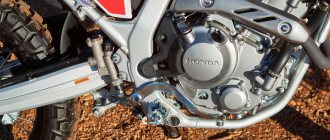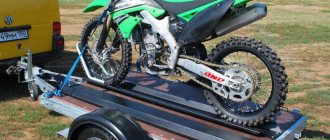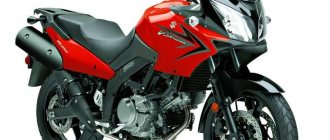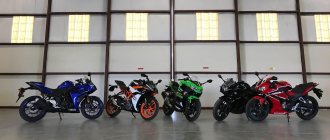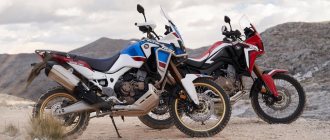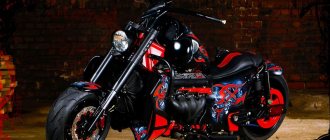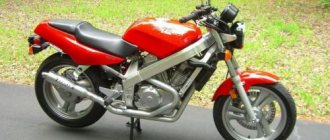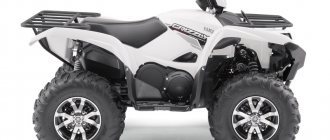Honda CB300F (2015-2018)
Honda CB300F naked model
appeared in 2015 along with the Honda CBR300R. Both models are built on a single platform, differing from each other only in appearance and ergonomics. The Honda CB300F was available in the North American, Australian and Asian (Thailand) markets.
The motorcycle was based on a 1-cylinder liquid-cooled engine with a volume of 286 cm³, producing 30.5 hp. power and 27 Nm of torque. Maximum motor performance is from 7000 to 8500 rpm.
In general, the Honda CB300F is distinguished by its budget design - steel frame, simple suspension, single-disc front brake. However, like any modern motorcycle, the model has an injection power system, a functional liquid crystal dashboard and versions with ABS.
2018 was the last year of production of the Honda CB300F, after which it was replaced by a new model, the Honda CB300R.
The main competitors of the Honda CB300F in the class:
- Kawasaki Z300
- Suzuki GSR/GW 250
- Yamaha MT-03 (since 2016)
Brief history of the model
- 2015 - start of production and sales.
Model
: Honda CB300F + ABS (North America, Australia, Asia).
Factory designation
: CB300FF + CB300FAF.
- 2016 - no significant changes.
Model
: Honda CB300F + ABS (North America, Australia, Asia).
Factory designation
: CB300FG + CB300FAG.
- 2017 - no significant changes.
Model
: Honda CB300F + ABS (North America, Asia).
Factory designation
: CB300FH + CB300FAH.
- 2018 is the last year of production.
Model
: Honda CB300F + ABS (North America).
Factory designation
: CB300FJ + CB300FAJ.
Honda CB300F 2015 motorcycle review
The Honda motorcycle for beginners has been stripped down a bit.
The 2015 Honda CB300F It's essentially a stripped-down CBR300R.
Less is more
The appearance of the CB300F and CBR300R perfectly shows the difference between the two models. Essentially, the CB300F is a 300R that has had almost the entire body removed from the front of the engine, replaced the dual headlight with a single headlight, and installed a one-piece handlebar. Otherwise the motorcycles are almost identical.
This means the 300F features the same frame, wheels, brakes, tires and suspension as the 300R. And of course, both motorcycles have a 286 cc, single-cylinder, liquid-cooled, counterbalanced engine. This engine, in turn, is a larger version of the 249cc four-valve DOHC engine that was introduced in last year's CBR250R. In general, you can refer to the CBR300R reviews and specifications for more information.
This animation perfectly demonstrates the difference between a dressed-up CBR00R and a stripped-down CB300F. It's really just a matter of the design of the body and steering wheel.
According to Honda representatives, the increase in power compared to its predecessor is 17%, and judging by dynamometer tests, the manufacturer's claims are true. The new motorcycle produces 26.2 horsepower at 8500 rpm, surpassing the CBR250R by exactly 17% (22.5 horsepower). Torque is rated at 23.5 Newton meters at 6,800 rpm - not exactly a lot, but plenty for the class and again 17% more than the 250R.
The 286cc 300F is a long-stroke version of the CBR250R, so it's no surprise that its curve is almost exactly the same as the previous engine, only higher on the graph.
In addition, the 300F is slightly lighter and cheaper than the R model: by 4 kilograms and $400 dollars, respectively (if we take into account prices in the USA - $3999 for the CB300F).
Impressions from the test drive
The driving experience of the CB300F is not much different from the CBR300R, which is to be expected. The most obvious difference is the driving position, or more specifically how forward the driver leans. The 300R's driving position sits slightly forward to reach the steering wheel, while the 300F's driving position is much more neutral thanks to its one-piece, raised handlebar.
Another type of steering wheel provides an upright and neutral driving position.
One of the advantages of a single-cylinder engine, especially for beginners, is that it is narrow. This ensures that the driver's legs are not spread too far apart when he sits behind the wheel. In addition, in addition to the rather modest seat height (780 mm), the narrowness of the seat and gas tank allows short drivers to reach the ground with both feet.
The clutch is squeezed out quite tightly, which should give the novice driver confidence at the start. Most test drivers were pleased with the fuel delivery and smooth operation of the Honda CB300F engine, although some may find the transitions from idle to acceleration and vice versa to be harsh. The gearshift lever moves clearly and without problems from one gear to another, so it is easy not only to start from a standstill, but also to change gears as you accelerate.
Since the new naked has more power and torque than the 250R, acceleration is faster. The 300F is easier to keep up with traffic on the freeway than other small displacement bikes, including the 250R. You can even increase the speed when overtaking, as the motorcycle feels comfortable at speeds of 140 kilometers per hour and more if there is enough space.
The suspension, designed for everyday comfort, has a negative impact on cornering performance. The main thing is not to lose stability and smooth movement, and everything will be as it should.
I was also pleasantly surprised by the low level of engine vibration. Single-cylinder engines are notorious for being loud at high speeds, but Honda's designers have worked hard to reduce vibration on the CB300F. It is felt only at speeds of 120 kilometers per hour, and then more on the footpegs than on the steering wheel. If you do not exceed the speed, the motorcycle will operate very smoothly and without vibration.
The CB's handling is good and the steering position makes it easy to navigate corner after corner. The 37mm fork and preload-adjustable shock absorber are tuned quite softly. Wild rides on country roads are not the bike's strong point, but riders who prefer smoothness to aggressiveness will be pleased.
The only thing we can criticize about the new CB300F are the brakes. The motorcycle is equipped with a 296 mm disc at the front and a 220 mm rear disc, and the braking system can be called satisfactory, but nothing more. Of course, nothing outright bad, but the test bike had, for example, a brake lever that was not stiff enough, which is not the case on the CBR300R. Perhaps some new pads and steel-wrapped brake lines could improve the situation.
New era
Almost since time immemorial, the best motorcycles for beginner motorcyclists have been considered the Kawasaki Ninja or CBR. But it looks like the situation may be changing. With the new CB300F, the driver gets the full performance of the above-mentioned machines with some advantages.
Firstly, the solid handlebar, instead of the design found on the CBR300R, is better suited for normal riding and makes low-speed maneuvers a little easier for beginners. Secondly, the 300F is slightly cheaper than the CBR (and Ninja 300). Thirdly, and more importantly, the absence of body kits and other body elements means that the motorcycle tipping over (which is inevitable) will not have dire consequences. Add in the ease of maintenance thanks to the same naked design, and the CB300F becomes a very attractive option as a first motorcycle.
But that doesn't mean the 300F is boring and basic for experienced drivers. Its relatively low power will keep you out of trouble and at the same time makes the bike an excellent tool for honing your driving technique. Moreover, the motorcycle has very good fuel consumption (a test drive showed about 3.9 liters per 100 kilometers), so the CB300F is a comfortable and nimble motorcycle for drivers with different skill levels.
Specifications
Technical characteristics of Honda CB300F:
| Model | Honda CB300F |
| Motorcycle type | naked |
| Year of issue | 2015-2018 |
| Frame | steel diagonal |
| engine's type | 1-cylinder, 4-stroke |
| Working volume | 286 cm³ |
| Bore/Stroke | 76.0 x 63.0 mm |
| Compression ratio | 10,7:1 |
| Cooling | liquid |
| Number of valves per cylinder | DOHC, 4 valves |
| Fuel supply system | injector, PGM-Fi x1 38 mm |
| Ignition type | fully transistorized |
| Maximum power | 30.4 hp (22.7 kW) at 8500 rpm |
| Maximum torque | 27.0 Nm (2.8 kgm) at 7250 rpm |
| Clutch | Multi-disc in oil bath, cable drive |
| Transmission | 6-speed |
| type of drive | chain |
| Front tire size | 110/70-17M/C (54S) |
| Rear tire size | 140/70-17M/C (66S) |
| Front brakes | 1 disc 296 mm, 2-piston caliper (CB300FA - ABS) |
| Rear brakes | 1 disc 220 mm, 1 piston caliper (CB300FA - ABS) |
| Front suspension | 37 mm telescopic fork (non-adjustable), travel - 118 mm |
| Rear suspension | pendulum Pro-Link with monoshock absorber (adjustable preload), stroke - 104 mm |
| Length | 2035 mm |
| Width | 760 mm |
| Height | 1045 mm |
| Wheelbase | 1380 mm |
| Minimum ground clearance (clearance) | 150 mm |
| Seat height | 780 mm |
| Acceleration 0-100 km/h (0-60 mph) | 6.3 sec. |
| Maximum speed | 157 km/h[1] |
| Gas tank capacity | 13.0 l |
| Motorcycle weight (curb) | 158 kg 161 kg – CB300FA (ABS) |
When 300 “cubes” is better than a liter. Honda CB300R Neo Sports Caffe test
Today, all motorcycle manufacturers are simply obliged to produce small-capacity models in each class. Unless, of course, they want to fight for the new generation of motorcyclists (and their ages are completely different), for whom these “liters” of yours are not interesting and do not need them.
Egor Timofeev
I am testing a new product from last year - Honda CB300R Neo Sports Caffe. This is the youngest and most affordable of the three models of the Neo Sports Caffe family. Outwardly they are very similar: it seems that many parts are interchangeable.
In the design of motorcycles, there is an automotive tendency towards uniformity of appearance across the entire line of models.
The assembly and appearance of the Honda CB300R are of Japanese quality, although the motorcycle is produced in Thailand. I've been to those parts and I can say that such a 300 cc Honda in Southeast Asia is considered luxury with excess power. For us, an engine with a volume of 286 cubic meters, producing 31 horsepower, is for “first-season drivers” at best.
I was pleased with the gearbox, namely the precision with which Honda engineers selected the gear ratios. The engine and gearbox work for performance and, when accelerating, allow the motorcycle to accelerate as efficiently as possible. Cooperation with suspension manufacturer Showa can also be called successful. The motorcycle performs well in urban conditions, vigorously diving between the rows. On a country road, the suspensions are not annoying with their rigidity and eat up most of the bumps, which has a beneficial effect on the health and mood of the rider.
I would like to write about the brakes very simply - they exist, and they have ABS. They can’t do anything supernatural, and it’s not required of them. Let it be this: the braking force is enough to stop predictably.
If I said that the Honda CB300R is a pleasure to ride, you might think I was lying, and you wouldn't be far from the truth. In defense of this little beast, I will note that it is very convenient in the city. It is the smallest in its class, which means you can get through cracks that competitors can’t even think of.
On a long trip I liked the work of the suspension, everything was clear and moderately rigid. If you don’t rev the engine too loud, you’ll be pleasantly surprised by the fuel consumption – at a speed of about 100 km/h the motorcycle consumes some drops.
If we compare the CB300R with its competitors, the Honda looks nicer and more modern than the rest. But it is inferior to all classmates in dynamics. But, most likely, the CB300R motor has a longer service life. And again, “but” - Honda is much more expensive than its classmates. If you want to stand out, feel free to buy a CB300R - and all owners of classmate motorcycles will look at you with envy, knowing that your motorcycle is the most expensive.
| Dimensions (length/height/saddle height) | 2012x802x799 mm |
| Base | 1352 mm |
| Fuel tank volume) | 10 l |
| Engine | 286 cm3, 1‑cylinder, 4‑stroke, liquid cooling, 31 l. s., 27.5 Nm |
| Transmission | mech., 6-speed, drive - chain |
| Suspension (front/rear) | 41mm Showa inverted fork, 130mm travel / Pro-Link progressive monoshock and swingarm, 107mm travel |
| Brake (front/rear) | Radial 4-piston Nissin caliper, 1 floating disc 296 mm / 1 disc with 1-piston caliper Ø 220 mm |
| Curb weight | 143 kg |
| Technologies | ABS, diode optics |
The editors recommend:
KAMA PRO - extended-life tires
The Russian car market has collapsed by 20%
Service station workers face prison for driving a client's car
Russian car dealers have surpassed Italian ones
- Honda CB300R
- Test Drive
Discussion Cancel
2 comments
- Sergey:
10/07/2020 at 15:13
What competitors are you talking about? I’m interested in specific models) I’m choosing my first motorcycle
Answer
- Alexei:
13.10.2020 at 13:18
KTM DUKE 390 for example and Husqwarna Vitpilen/Svartpilen 401 (already more expensive).
Answer
